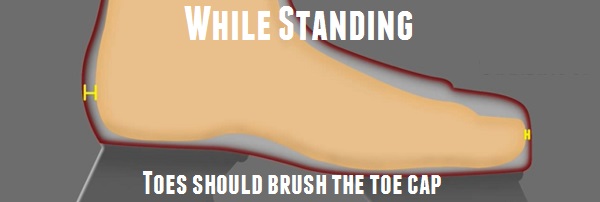How to get a Good Fitting for Hockey Skates
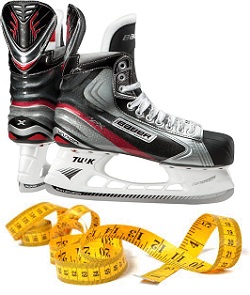 Hockey Skate Sizes – What size hockey skate should you wear?
Hockey Skate Sizes – What size hockey skate should you wear?
If you go to a local sports shop and the employee asks you what your skate size is and then gets that size for you, that's a red flag. He should basically ignore your assumption of your size, and measure you.
Hockey skates are typically 1-2 sizes lower than the shoe size you wear. However there are differences between different skate companies.
What are the Different Skate Sizes and Fits?
Skates have many different fitting characteristics so if the LHS employee tries to sell you the first skate you try on, that’s another red flag. When fitting a skate you are looking for more than just the right size, skates should be fitted according to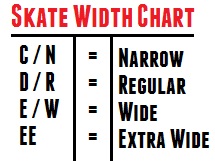
- Skate size
- Skate width
- Depth / arch
- Your weight
- Your skating ability/ skating style / playing level
Different lines from different skate companies will offer different fits. So lets say you are a size 8, a size 8 in Bauer Vapor might fight you great, but a size 8 in Easton might not feel right. This is because of differences in the overall width of the skate, width of the toe, depth of the skate, volume in the heel pocket, etc.
What Skate Will Fit Your Feet?
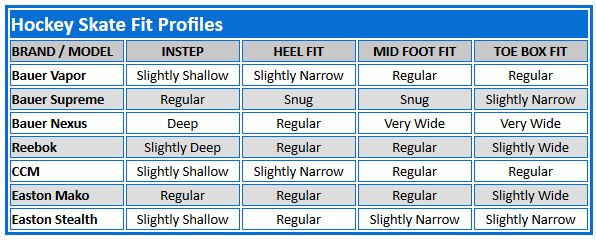 Remember each of the models shown above also come in sizes C, D, E or EE. However a Bauer Nexus 8D would be a looser fit than a Bauer Supreme 8D
Remember each of the models shown above also come in sizes C, D, E or EE. However a Bauer Nexus 8D would be a looser fit than a Bauer Supreme 8D
How to Test if Your Skates Fit Properly
There are two popular tests when it comes to fitting hockey skates: the pencil test, and the finger test.
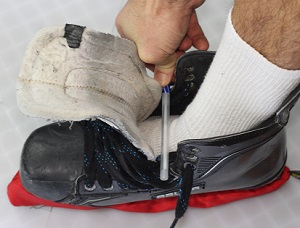 With the pencil test you will put on your skates, but do not tie them up. Pull the tongue out and then take a pencil or pen and place it across the eyelets, about three eyelets down.
With the pencil test you will put on your skates, but do not tie them up. Pull the tongue out and then take a pencil or pen and place it across the eyelets, about three eyelets down.
If the pen / pencil lies flat without rocking back and forth on your foot then the skate has good depth. If the pen / pencil hits your foot without touching both eyelets then the skate is too shallow for you.
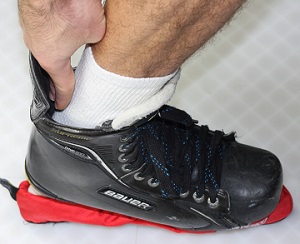 The finger test will ensure your skates are the right size, and that you have the right ankle fit. Lace the skate up tight as if you are going to play hockey. Lean forward and bend your knees (like you are in the hockey stance).
The finger test will ensure your skates are the right size, and that you have the right ankle fit. Lace the skate up tight as if you are going to play hockey. Lean forward and bend your knees (like you are in the hockey stance).
Now reach back to the heel of the skate and see how much of a gap there is between your heel and the skate. If you can slide more than one finger between your heel and the skate (not the tendon and skate) then the skate is not locking your ankle / heel into place and the fit is not suitable for you. For children who are still growing a 1 finger gap is fine. If your child's feet have stopped growing you can go for a bit of a snugger fit. Skates that are too loose can cause blisters, foot pain, and impair your skating ability.
Where Should my Toes Touch on my Skates
The Toe Brush Test – Another popular way to tell if the skates are the proper size is where your toes lie in the skates. With your skates laced up, stand up straight in the skates, in this stance your toes should just brush the toe cap inside the skates. Now get into an athletic stance (the hockey stance) in this stance your heel should lock more into place and your toes should not be rubbing on the toe cap anymore.
 Skate Stiffness – Give your Skates a Squeeze
Skate Stiffness – Give your Skates a Squeeze
The stiffness of your skates is also important when considering the right fit. Some skates are designed with very stiff boots and some are designed with less stiff boots. Typically stiffer boots are recommended for more experienced hockey players, and heavier players. The stiffer the boot, the more ankle support and energy transfer you will get, however stiffness can compromise mobility in some cases.
 Newer hockey players should probably not get the stiffest boots available as they may not be aggressive enough in their skating to properly break the skates in and get the full advantage. However new players should not buy skates with very little stiffness as these skates will not provide enough support for playing hockey on a regular basis.
Newer hockey players should probably not get the stiffest boots available as they may not be aggressive enough in their skating to properly break the skates in and get the full advantage. However new players should not buy skates with very little stiffness as these skates will not provide enough support for playing hockey on a regular basis.
To determine the stiffness, give your skates a squeeze. Hold the skate below the tendon guard and squeeze the sides together. If it folds in easily these skates are too weak for hockey. If there is some good resistance then they are good for a newer hockey player, and if they are very stiff they are suitable for experienced players.
Get Your Skates Baked
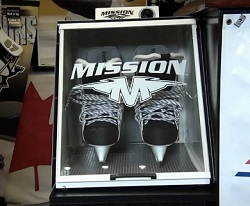 When new players hear about baking skates they might think it’s a bit crazy, but high end skates are designed to be heat molded to fit your feet. While you can bake them yourself at home (only if you know what you are doing) the best time to get your skates baked is at the store before your purchase them.
When new players hear about baking skates they might think it’s a bit crazy, but high end skates are designed to be heat molded to fit your feet. While you can bake them yourself at home (only if you know what you are doing) the best time to get your skates baked is at the store before your purchase them.
How does skate baking work?
After you find a comfortable pair of skates that fits you properly the store associate will take your pair of skates and put them into a special oven for a few minutes. When the skate is warm it is ready to be put on your feet. You gently lace the skate up while sitting in a chair and then sit for about 10 minutes while the skates cool and form fit to your foot. This process gives your skate a custom fitted mold to really lock your foot into place and give you the most comfortable experience.
Is it Normal for my Feet to Hurt after Skating?
 When you first skate in your new skates, yes, it is normal for there to be a little discomfort. It is normal to get the odd blister, or a bit of a pain. This discomfort should only affect you the first few times you use your skates. This is the normal process of breaking in a new pair of skates. After your skates are broken in you should be able to skate in them without any pain or blisters.
When you first skate in your new skates, yes, it is normal for there to be a little discomfort. It is normal to get the odd blister, or a bit of a pain. This discomfort should only affect you the first few times you use your skates. This is the normal process of breaking in a new pair of skates. After your skates are broken in you should be able to skate in them without any pain or blisters.
What happens if your feet hurt every time you skate in them
If you’ve skated 10+ times and your skates still hurt your feet then there is a problem. Your skates may not fit you properly, or you may have unique feet that need special attention. You can customize your skates by getting custom insoles (superfeet are popular), or by taking them to a pro shop to get them “punched”. Lets say you have extra wide ankles, you can get the sides of your skates punched to give you some more room.
Buying Skates Online vs In Stores
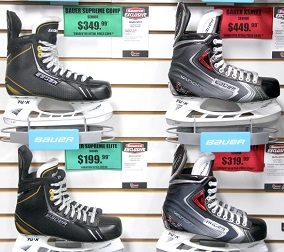 If you are a new player it’s a good idea to buy your skates in the stores. A good employee can help you find the right fitting skate for your foot. After reading this article you should have a good idea of what you need, now it’s up to the employee to help you find it.
If you are a new player it’s a good idea to buy your skates in the stores. A good employee can help you find the right fitting skate for your foot. After reading this article you should have a good idea of what you need, now it’s up to the employee to help you find it.
If you decide to buy online you should always look for a good return policy. If you find a great deal, make sure the skates still are covered under the return policy. This way you can buy the skates, try them on, and if they don’t fit properly you can still return them.

